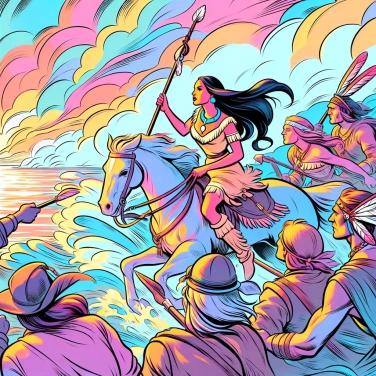Pocahontas played a crucial role in American colonization history as a mediator between English colonists and Native Americans, helping to establish diplomatic relations and prevent conflicts.

At the beginning of the 17th century, English colonists land on the shores of what is now called Virginia, with the aim of settling permanently and taking advantage of local resources. But conflicts quickly arise with the Native American groups already living there, particularly the Powhatans, a powerful confederation led by Chief Powhatan, the father of Pocahontas. At the time, things are tense: famine, diseases, exchanges that are sometimes friendly, sometimes violent... in short, a coexistence that is not exactly easy. It is precisely in this unstable context that young Pocahontas grows up and will be called upon to play a key role in the relations between the two peoples.
Pocahontas was primarily an essential intermediary between her Powhatan tribe and the new English arrivals. She regularly spoke with the colonists, particularly John Smith, whom she is said to have saved from execution. Through her frequent interventions, she allowed these two completely different communities to understand each other and avoid several violent conflicts. Pocahontas also facilitated the exchange of food, tools, and negotiations. Without her, the early days would surely have been much more difficult for the colonists, even chaotic. Her role as a cultural mediator thus really weighed in on maintaining the very fragile peace between the English and the Native Americans.
The conversion of Pocahontas to Christianity and her marriage to the English colonist John Rolfe in 1614 were seen as powerful political and cultural symbols. By becoming Christian under the name Rebecca, Pocahontas represented to the English the possibility of integrating Native American populations into European culture. Her marriage allowed for a period of relative peace between the colonists and the Powhatans, temporarily easing significant tensions. This union was viewed as the very example of possible harmony between two very different worlds, even though the reality was much more nuanced and complex than this idealized image.
At the beginning, the English colonists in Jamestown were really struggling: diseases, famines, tense encounters with local tribes... Pocahontas clearly saved them more than once. She brought food to the colonists during the harsh winter, preventing certain famine. Most importantly, she helped establish regular and peaceful exchanges with her people, the Powhatans. Pocahontas's marriage to John Rolfe greatly facilitated American-English relations, providing the colony with the stability essential for its survival and expansion. Thanks to this more serene climate, the colonists were able to focus on agriculture, particularly the lucrative cultivation of tobacco, the economic engine of these early colonies. In short, without Pocahontas, it's hard to imagine the rapid and lasting success of Jamestown, a decisive starting point for English colonization in America.
The legend of Pocahontas quickly became a founding myth in the United States, shaping for centuries the popular image of Indigenous peoples. She is often portrayed as the ideal Native American in the eyes of the colonists: welcoming, peaceful, and ready to adopt European culture. As a result, this story simplified and idealized the complex relationships between Indigenous peoples and Europeans, creating two strong stereotypes: either the natives were seen as dangerous savages, or as exotic and romantic figures capable of easily integrating. This had lasting consequences in American culture, even influencing films and cartoons to this day, such as the famous Disney movie. The problem is that this romanticized vision obscures the often violent and unjust reality of contacts between Europeans and Indigenous peoples, simultaneously erasing much of their history and true identity.
Unlike popular narratives, the historical reality of Pocahontas saving John Smith's life is still debated by historians today, and some believe it may be a symbolic or misinterpreted episode.
Pocahontas is considered one of the first cultural ambassadors of North America, having traveled to England where she was received at the court of King James I.
Direct descendant of Pocahontas, the First Lady of the United States Edith Wilson (wife of President Woodrow Wilson) publicly took pride in this Native American heritage.
Pocahontas's real name was Matoaka, with Pocahontas actually being a nickname meaning "little mischievous one" or "one who plays a lot" in the Powhatan language.
The story and legend of Pocahontas have greatly influenced the way Native Americans have been represented in American culture: sometimes romanticized and idealized, other times simplified or caricatured. In particular, Pocahontas often appears as a romantic and intercultural symbol in narratives, films, and literary works, thus shaping the public's perception of Indigenous peoples.
Pocahontas became a crucial mediator through her actions aimed at fostering communication and understanding between the English and the Native Americans. Through her interventions, the negotiations she participated in, and her marriage to the Englishman John Rolfe, she helped maintain periods of peace and economic cooperation between these two cultures that often had opposing interests.
The marriage between Pocahontas and John Rolfe is significant in several ways. Historically, this event created a temporary period of peace between the English settlers and the Powhatan Indian tribe. More broadly, this union symbolizes the early attempts at peaceful coexistence and cultural assimilation, and it facilitated the expansion of the English colonies by stabilizing territorial and economic relations.
According to several historical accounts, Pocahontas played an important role in the survival of the first English colony in Virginia, particularly by providing food, warning the settlers of dangers, and facilitating trade relations with the Native Americans. Her assistance helped avert widespread famine and ensured the sustainability of the colonial settlement at Jamestown.
Pocahontas was a real historical figure, the daughter of the Native American chief Powhatan. Although she is often referred to as a princess in popular culture, this title is a romanticized simplification. She played an active role as a mediator between the English settlers and her people, thus contributing to the early cultural exchanges and diplomacy between these two groups.

0% of respondents passed this quiz completely!
Question 1/5